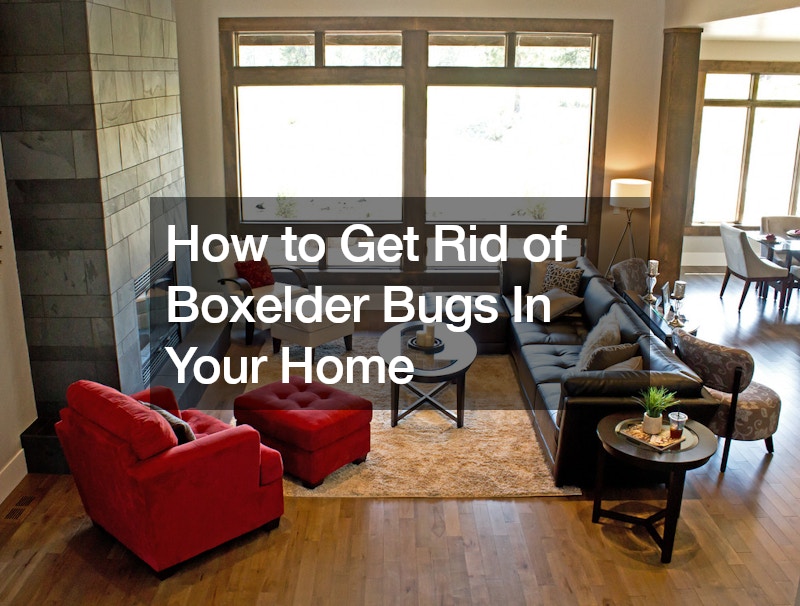Boxelder bugs, native to the western United States, can be a significant nuisance for homeowners, especially during Fall and Spring when they seek shelter indoors. While they typically do not cause economic damage, their presence can be bothersome. Fortunately, there are several practical methods homeowners can employ to manage and control boxelder bug infestations.
Understanding Boxelder Bugs
Boxelder bugs are primarily associated with Boxelder Trees, feeding on developing seeds of these trees and related species like maples and ash. They often gather in large numbers on sunny walls of buildings, seeking warmth in Fall and Spring.
While not harmful to humans or pets, their presence indoors can be undesirable.
Prevention Measures
Sealing Entry Points:
Inspect your home for cracks, gaps, and openings where boxelder bugs may enter. Seal these entry points using caulk or weather stripping around windows, doors, and utility openings to prevent infiltration.
Here are some key entry points to watch out for and tips on how to seal them effectively:
Windows and Doors: Check for gaps around window frames and door jambs where boxelder bugs could squeeze through. Apply weather stripping along the edges of windows and doors to create a tight seal. Ensure that screens are intact and free of tears or holes that could serve as entry points for pests.
Utility Openings: Inspect utility openings such as vents, pipes, and electrical outlets for gaps or cracks. Seal these openings with silicone caulking or expanding foam to prevent boxelder bugs from entering your home through utility penetrations.
Foundation Cracks: Examine the exterior foundation of your home for cracks or gaps where boxelder bugs could gain access. Use mortar or concrete filler to seal any cracks in the foundation and prevent pests from finding their way indoors.
Siding and Exterior Cladding: Look for gaps or loose panels in siding or exterior cladding where boxelder bugs could enter. Repair or replace damaged siding and ensure that seams are properly sealed to deter pests from infiltrating your home’s exterior.
Roof Vents and Eaves: Check roof vents, eaves, and soffits for gaps or openings where boxelder bugs may enter. Install mesh screens or covers over vents and openings to prevent pests from accessing your attic or crawl space.
Maintaining Outdoor Areas:
Keep vegetation trimmed and remove debris, such as fallen leaves and woodpiles, from around your home’s exterior. Boxelder bugs are attracted to cluttered outdoor spaces, so maintaining cleanliness can deter them from congregating near your home.
Regular Cleaning:
Vacuuming up boxelder bugs indoors is an effective way to remove them. Be sure to dispose of the vacuum bag properly by sealing it in a plastic bag and freezing it overnight to kill the bugs before disposal.
Using Soapy Water Solution:
Create a soapy water solution by mixing liquid dishwashing soap with water and spraying it on boxelder bugs congregating on the exterior walls of your home. This solution disrupts their protective waxy layer, leading to dehydration and death.
Professional Assistance:
While DIY methods can effectively manage minor boxelder bug infestations, severe or persistent problems may require professional intervention. Consider calling in a pest control specialist for the following scenarios:
Severe Infestations:
If boxelder bugs have infested your home extensively, professional exterminators have the expertise and resources to address the issue comprehensively. They can implement targeted treatments and provide long-term solutions for effective boxelder bug control.
Persistent Infestations:
Despite your best efforts, if boxelder bugs continue to invade your home repeatedly, professional assistance may be necessary. Pest control professionals can conduct thorough inspections to identify underlying causes and implement customized treatment plans to eradicate the infestation.
Structural Damage:
Boxelder bugs do not cause structural damage, but their presence can indicate underlying issues such as cracks or openings in your home’s foundation. Pest control professionals can assess and address these structural issues to prevent future infestations and ensure the integrity of your home.
Environmentally Friendly Approach:
When dealing with boxelder bugs, it’s essential to prioritize environmentally friendly methods over toxic pesticides. While chemical pesticides may offer quick results, they can harm human health and the environment. Instead, opt for non-toxic solutions like soapy water or physical removal methods like vacuuming.
Here are specific toxic solutions to watch out for and why you should avoid them:
Synthetic Insecticides: Products containing synthetic insecticides such as pyrethroids, organophosphates, or neonicotinoids should be avoided. While effective at killing boxelder bugs, these chemicals can also harm beneficial insects, wildlife, and aquatic organisms. Additionally, prolonged exposure to synthetic insecticides can pose health risks to humans, especially children and pets.
Foggers and Aerosols: Foggers and aerosol insecticides release fine droplets or particles into the air to kill boxelder bugs on contact. However, these products can also disperse harmful chemicals throughout your home, posing respiratory risks to occupants. Inhalation of aerosolized pesticides can irritate the respiratory tract and exacerbate existing respiratory conditions.
Residual Sprays: Residual sprays are designed to leave behind a toxic residue on surfaces, providing long-lasting protection against boxelder bugs. However, these residues can linger on indoor surfaces, potentially exposing household members to harmful chemicals through skin contact or ingestion. Additionally, residues can accumulate in the environment, contaminating soil and water sources.
In conclusion, managing boxelder bug infestations requires a combination of preventive measures, regular maintenance, and, in some cases, professional assistance. By implementing these strategies and staying vigilant, homeowners can effectively control boxelder bugs and maintain a pest-free home environment. Remember to prioritize environmentally friendly methods to ensure the safety of your family and pets.
.
